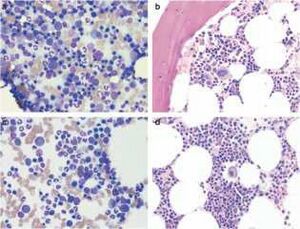Difference between revisions of "Haematopoiesis and distribution of cells in the body"
Fiorecastro (talk | contribs) |
|||
| Line 1: | Line 1: | ||
| − | Erythrocytes, platelets and granulocytes (neutrophils, eosinophils and basophils) are derived from pluripotential stem cells. These give rise to multipotential colony-forming unit progenitors for granulocytes, erythrocytes, monocytes/macrophages and megakaryocytes. Under the influence of interleukins and colony-stimulating factors, committed stem cells develop into differentiated blood cells (erythrocytes, neutrophils, eosinophils, basophils, monocytes and platelets). Neutrophils and monocytes develop from the same colony-forming unit. Although the bone marrow produces some lymphocytes most are derived from the peripheral lymphoid tissue. | + | [[File:NationWide Logo.jpeg|right|link=https://www.nwlabs.co.uk/|alt=NationWide Logo|240x240px|In Partnership with NationWide Laboratories|frameless|thumb]]Erythrocytes, platelets and granulocytes (neutrophils, eosinophils and basophils) are derived from pluripotential stem cells. These give rise to multipotential colony-forming unit progenitors for granulocytes, erythrocytes, monocytes/macrophages and megakaryocytes. Under the influence of interleukins and colony-stimulating factors, committed stem cells develop into differentiated blood cells (erythrocytes, neutrophils, eosinophils, basophils, monocytes and platelets). Neutrophils and monocytes develop from the same colony-forming unit. Although the bone marrow produces some lymphocytes most are derived from the peripheral lymphoid tissue. |
[[File:NWL 2016 Labfacts inners A4 PRESS optimize(40).jpg|thumb|Bone marrow citology and histology ©NationWide Laboratories 2017]] | [[File:NWL 2016 Labfacts inners A4 PRESS optimize(40).jpg|thumb|Bone marrow citology and histology ©NationWide Laboratories 2017]] | ||
The bone marrow also contains a reserve of mature cells, which can be released into the circulation. Thus, changes in the blood are affected by the reserve capacity of the bone marrow and the life span of cells in the circulation (canine erythrocytes 120 days, platelets 10 days, granulocytes 8 hours). | The bone marrow also contains a reserve of mature cells, which can be released into the circulation. Thus, changes in the blood are affected by the reserve capacity of the bone marrow and the life span of cells in the circulation (canine erythrocytes 120 days, platelets 10 days, granulocytes 8 hours). | ||
| Line 13: | Line 13: | ||
== Authors and References == | == Authors and References == | ||
[[NationWide Laboratories]] | [[NationWide Laboratories]] | ||
| − | |||
| − | |||
[[Category:Haematology]] | [[Category:Haematology]] | ||
Revision as of 15:52, 26 April 2022
Erythrocytes, platelets and granulocytes (neutrophils, eosinophils and basophils) are derived from pluripotential stem cells. These give rise to multipotential colony-forming unit progenitors for granulocytes, erythrocytes, monocytes/macrophages and megakaryocytes. Under the influence of interleukins and colony-stimulating factors, committed stem cells develop into differentiated blood cells (erythrocytes, neutrophils, eosinophils, basophils, monocytes and platelets). Neutrophils and monocytes develop from the same colony-forming unit. Although the bone marrow produces some lymphocytes most are derived from the peripheral lymphoid tissue.
The bone marrow also contains a reserve of mature cells, which can be released into the circulation. Thus, changes in the blood are affected by the reserve capacity of the bone marrow and the life span of cells in the circulation (canine erythrocytes 120 days, platelets 10 days, granulocytes 8 hours).
Haematopoiesis may occur in other organs particularly the spleen, less frequently the liver and even peripheral lymph nodes, if there is a marked increase in demand for cells. With increased tissue demands, mature reserves are depleted and immature cells are released into the circulation.
Reticulocytes are immature RBCs released from normal bone marrow in increased numbers in response to anaemia. Although the nucleus has been lost, these cells still have ribosomal RNA in their cytoplasm for continued haemoglobin synthesis. Ribosomal RNA appears as blue granules when stained with new methylene blue. Cells showing polychromasia are reticulocytes but not all reticulocytes are polychromatic. In dogs a polychromatophil is a reticulocyte. In cats two types of reticulocytes are recognised, aggregate and punctate. Feline aggregate reticulocytes have distinctly clumped RNA and a 12 hour life span; these mature into punctate reticulocytes with only a few scattered granules of RNA, which have a 10-12 day life span in blood. Less mature RBCs, with a retained nucleus, may circulate in response to severe regenerative anaemias; these are usually metarubricytes although earlier cells may be seen.
A left shift is seen when immature granulocytes are released due to increased tissue demands. These immature cells are predominantly band neutrophils although metamyelocytes and occasionally myelocytes may be seen.
Leucocytes which appear in samples drawn for a complete blood count form part of the circulating pool of cells. A large number of cells remain in the marginal pool, associated with the endothelial lining of capillaries particularly in the lungs. As cells shift between pools the leucocyte counts vary. In dogs the size of the circulating and marginal pools are approximately equal while in cats the marginal pool is 2-3 times the size of the circulating pool. If fear, excitement or strenuous exercise stimulate mobilisation of cells from the marginal pool to the circulating pool, the WBC count may rapidly increase, up to 2 fold in dogs and 3 fold in cats.

